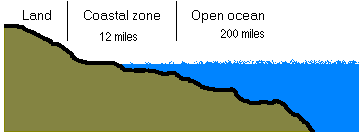Ocean on-pagers: Do we know enough of Oceans?
Marine Eco-zones

Planning for the sustainable use of marine resources must take into account the complexity and boundaries of marine ecosystems, the relationships between sectors that exploit marine resources, the effects of exploitation on these resources, and legal boundaries. This requires planning and management mechanisms at the community, national, regional and international levels. The mechanisms should resolve the conflicts that arise between sectoral uses and between users such as local and national fisheries and foreign fleets that exploit common resources such as shrimp or tuna.
Oceans and coastal regions provide a rich variety of ecosystems and eco-zones, facilitating a fertile biodiversity, both in terms of species and habitat. They include:
- Beaches
- A beach is a strip of land that lies along the edge of a body of water. Some beaches are small and rocky, while others are wide bands of sand. The material that forms beaches may be sediment carried to the land by rivers, sediment eroded from coastal rocks, or offshore material brought by waves. Therefore, beaches may be made up of brown sand brought from distant mountains, black sand eroded from a volcano, or white sand from nearby coral reefs.
- Coral reefs
- A coral reef is a ridge or mound composed of the chalky skeletons of former generations of coral animals, and serving as a platform for the living coral polyps. Reefs usually grow in the shallow, clear water of tropical oceans.
- Docks and Pilings
-
Certain man-made structures can also provide habitat for marine organisms. In areas where the water is relatively clean, docks support large communities of attached animals such as sponges, tube dwelling worms, anemones, barnacles and mussels. Motile animals including nudibranchs, sea stars, sea urchins and small fish also find food and shelter in this environment. Many World War II ships have been deliberately scuttled to provide habitats for marine life.
- Eelgrass Beds:
-
Seagrasses such as surfgrass or eelgrass often cover shallow areas of sea bottom. These grasses are not seaweeds, but are actually flowering plants. Seagrass
habitats are a major source of food and shelter for many organisms in near shore environments. They also help stabilize the soft bottoms of these habitats with their dense root systems.
- Kelp Forests:
-
Large, brown seaweeds - the kelps - are found throughout the cold temperate regions of the world's oceans. An entire assemblage of animals, including fish and marine mammals, use the various levels in the forest (canopy, stipes, holdfasts, bottom substrate) for shelter, reproduction and feeding. Kelp forests of the northeast Pacific have the highest measured primary productivity of all ecosystems.
- Mangroves Swamps
- A swamp is a wetland in which trees or shrubs are the dominant form of vegetation. It is permanently or periodically covered by water. The water that inundates the ground may be fresh or, as in mangrove swamps, salty.
- Mudflats
- Muddy shores are usually associated with estuaries, where fresh water flows into the sea. These areas tend to have low wave action which allows for fine sediment
nd organtic particles to accumulate. In spite of very low oxygen levels in the mud there are many inhabitants buried here. Bacteria are very abundant here and
provide an important food source for many creatures in the mudflat.
- Rocky shore:
-
Rocky shores have the great diversity of animal and plant species. They are densely populated with larger, more visible invertebrates including sea stars, mussels, barnacles, anemones, and a variety of intertidal seaweeds. The relatively high productivity of the area, contributes to its rich biodiversity. Organisms in intertidal zones must cope with changes in moisture levels, heat balance, temperature, and salinity as well as the mechanical stress from wave action.
- Saltmarches
- A salt marsh is a marsh in which the water that inundates the surface of the ground is salty. Most salt marshes form along coasts and are flooded and exposed by the action of tides.
- Sea Grass and Seaweed beds
- Seagrass and seaweed are common throughout tropical and temperate coastal waters. They are salt-tolerant and extract their carbon dioxide from the water. Meadows for seagrasses usually form interdependent ecosystems with mangroves and coral reefs. They allow for the migration of fauna for feeding, breeding and shelter, and regulate the flow of organize and inorganic nutrients which are washed down from the land and up from the sea.
- Wetlands
- A wetland is a vegetated area that is permanently or periodically covered by water, either fresh or salt. Examples are marshes, swamps, bayous, and bogs. Wetlands naturally filter and cleanse the water flowing from rivers and streams into the ocean. Estuaries - where the ocean tide meets a river current - depend on wetlands to maintain water quality.
- Marsh: A marsh is a wetland in which grasses and other herbaceous (non-woody) plants predominate.
- Swamp: A swamp is a wetland in which trees or shrubs are the dominant form of vegetation. The water that inundates the ground may be fresh or, as in mangrove swamps, salty.
- Bayou: A bayou is a sluggish stream that is part of a river delta or coastal swamp. Bayous occur in flat areas that have poor drainage.
- Bogs: A bog is a type of wetland typical of poorly drained ground in areas with cool climates. It forms when a lake or pond gradually fills with the debris of plants, especially sphagnum and other mosses. The decaying material forms peat, the first stage in the transformation of plant material into coal. Peat is often taken from bogs and used as fuel or fertilizer.
|
